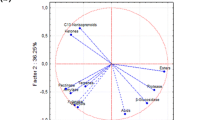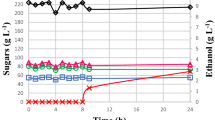Abstract
In this study, 19 indigenous mezcal Saccharomyces cerevisiae strains were screened for their tolerance to grow under different stress conditions and their potential use in fermentation. All strains were able to tolerate pH value of 3, significant levels of glucose (30%), ethanol (12% v/v), and temperature of 37 °C. Eleven of them were able to grow in presence of 15% of ethanol, but only CH7 and PA18 strains grew at 42 °C. Both were selected for evaluation of their fermentative abilities in maguey juice and in a synthetic medium incubated at 30 and 40 °C. Temperature of 40 °C had a positive effect on the ethanol production, increasing the productivity and efficiency in maguey fermentation. Ethyl acetate, isobutanol and isoamyl alcohols production was favored at 30 °C. Both evaluated strains presented a good fermentative capacity and production of volatile compounds, suggesting their potential use as starter cultures in mezcal fermentation.


Similar content being viewed by others
References
Aparecida-Oliveira V, Araújo-Vicente M, Gomes-Fieeto L, de Miranda-Castro I, Coutrim MX, Schüller D, Alves H, Casal M, de Oliveira-Santos J, Dias-Araújo L, Alves da Silva PH, Lopes-Brandão R. Biochemical and molecular characterization of Saccharomyces cerevisiae strains obtained from sugar-cane juice fermentations and their impact in cachaça production. Appl. Environ. Microbiol. 74: 693–701 (2008)
Badotti F, Belloch C, Rosa CA, Barrio E, Querol A. Physiological and molecular characterisation of Saccharomyces cerevisiae cachaça strains isolated from different geographic regions in Brazil. World J. Microbiol. Biotechnol. 26: 579-587 (2010)
Belloch C, Orlic S, Barrio E, Querol A. Fermentative stress adaptation of hybrids within the Saccharomyces sensu stricto complex. Int. J. Food Microbiol. 122: 188–195 (2008)
Beltran G, Novo M, Leberre V, Sokol S, Labourdette D, Guillamon JM, Mas A, François J, Rozes N. Integration of transcription and metabolic analysis for understanding the global responses of low-temperature winemaking fermentations. FEMS Yeast Res. 6: 1167–1183 (2006)
Díaz-Montaño DM, Délia ML, Estarrón-Espinosa M, Strehaiano P. Fermentative capability and aroma compound production by yeast strains isolated from Agave tequilana Weber juice. Enzyme Microb. Tech. 42: 608–616 (2008)
Jiménez-Martí E, Zuzuarregui A, Gomar-Alba M, Gutiérrez D, Gil C, del Olmo M. Molecular response of Saccharomyces cerevisiae wine and laboratory strains to high sugar stress conditions. Int. J. Food Microbiol. 145: 211–220. (2011)
Kirchmayr MR, Segura-García LE, Lappe-Oliveras P, Moreno-Terrazas R, de la Rosa M, Gschaedler-Mathis A. Impact of enviromental conditions and process modifications on microbial diversity, fermentation efficiency and chemical profile during the fermentation of mezcal in Oaxaca. LWT—Food Sci. Technol. 79: 160–169 (2017)
Legras JL, Karst F. Optimization of interdelta analysis for Saccharomyces cerevisiae strain characterization. FEMS Microbiol. lett. 221: 249–255 (2003)
Liu PT, Lu L, Duan CQ, Yan GL. The contribution of indigenous non-Saccharomyces wine yeast to improved aromatic quality of Cabernet Sauvignon wines by spontaneous fermentation. LWT - Food Sci. Technol.71: 356–363 (2016)
Molina AM, Swiegers JH, Valera C, Pretorius IS, Agosin E. Influence of wine fermentation temperature on the synthesis of yeast-derived volatile aroma compounds. Appl. Microbiol. Biotechnol. 77: 675–687 (2007)
Mouret JR, Camarasa C, Angenieux M. Aguera E, Perez M, Farines V, Sablayrolles JM. Kinetic analysis and gas-liquid balances of the production of fermentative aromas during winemaking fermentations: effect of assimilable nitrogen and temperature. Food Res. Int. 62: 1-10 (2004)
Norma Oficial Mexicana NOM-070-SCFI-2016. Bebidas alcohólicas-mezcal-especificaciones. Secretaria de economía. Publicada en el Diario Oficial de la Federación el 23 de febrero de 2017
Novo M, Gonzalez R, Bertran E, Martínez M, Yuste M, Morales P. Improvement fermenation kinetics by wine yeast strains evolved under ethanol stress. LWT-Food Sci. Technol. 58: 166–172 (2014)
Nuñez-Guerrero ME, Páez-Lerma JB, Rutiaga-Quiñones OM, González-Herrera SM, Soto-Cruz NO. Performance of mixtures of Saccharomyces and non-Saccharomyces native yeasts during alcoholic fermentation of Agave duranguensis juice. Food Microbiol. 54: 91–97 (2016)
Páez-Lerma JB, Arias-García A, Rutiaga-Quiñones OM, Barrio E, Soto-Cruz NO. Yeasts isolation from the alcoholic fermentation of Agave duranguensis during mezcal production. Food Biotechnol. 27: 342–356 (2013)
Pavel AB, Vasile CI. PyElph-a software tool for gel image analysis and phylogenetics. BMC Bioinformatics. 13: 9–14 (2012)
Prado-Jaramillo N, Estarrón-Espinosa M, Escalona-Buendía H, Cosío-Ramírez R, Martín-del-Campo S. Volatile compound generation during different stages of the tequila production process. A preliminary study. LWT-Food Sci. Technol. 61: 471–483 (2015)
Regodón JA, Peréz F, Valdés ME, De Miguel C, Ramírez M. A simple and effective procedure for selection of wine yeast strains. Food Microbiol. 14: 247–254 (1997)
Rodríguez ME, Infante JJ, Molina M, Domínguez M, Rebordinos L, Cantoral JM. Genomic characterization and selection of wine yeast to conduct industrial fermentations of a white wine produced in a SW Spain winery. J. Appl. Microbiol. 108: 1292–1302 (2010)
Rollero S, Bloem A, Camarasa C, Sanchez I, Ortiz-Julien A, Sablayrolles JM, Dequin S, Mouret JR. Combined effects of nutrients and temperature on the production of fermentative aromas by Saccharomyces cerevisiae during wine fermentation. Appl. Microbiol. Biotechnol. 99: 2291–2304 (2015)
Santiago-Urbina JA, Arias-García JA, Ruiz-Terán F. Yeast species associated with spontaneous fermentation of taberna, a traditional palm wine from the southeast of Mexico. Ann. Microbiol. 65: 287–296 (2015)
Segura-García LE, Taillandier P, Brandam C, Gschaedler A. Fermentative capacity of Saccharomyces and non-Saccharomyces in agave juice and semi-synthetic medium. LWT-Food Sci. Technol. 60: 284–291 (2015)
Serra A, Strehaiano P, Taillandier P. Influence of temperature and pH on Saccharomyces bayanus var. uvarum growth; impact of a wine yeast interspecific hybridization on these parameters. Int. J. Food Microbiol. 104: 257–265 (2005)
Settani L, Sannino C, Francesca N, Guarcello R, Moschetti G. Yeast ecology of vineyards within Marsala wine area (Western Sicily) in two consecutives vintages and selection of autochthonous Saccharomyces cerevisiae strains. J. Biosci. Bioeng. 114: 606–614 (2012)
Stanley D, Bandara A, Fraser S, Chamber, PJ, Stanley GA. The ethanol stress response and ethanol tolerance of Saccharomyces cerevisiae. J. Appl. Microbiol. 109: 13–24 (2010)
Sun Y, Guo J, Liu F, Liu Y. Identification od indigenous yeast flora isolated from the five winegrape varieties harvested in Xiangning, China. Antonie Van Leeuwenhoek. 105: 533–540 (2014)
Torrea D, Valera C, Ugliano M, Ancin-Azpilicuenta C, Francis IL, Henschke PA. Comparison of inorganic and organic nitrogen supplementation of grape juice-effect on volatile composition and aroma profile of a Chardonnay wine fermented with Saccharomyces cerevisiae yeast. Food Chem. 127: 1072–1083 (2011)
Vera-Guzmán AM, López MG, Chávez-Servia JL. Chemical composition and volatile compounds in the artisanal fermentation of mezcal in Oaxaca, Mexico. Afr. J. Biotechnol. 11: 14344–14353 (2012)
Verdugo-Valdez A, Segura García L, Kirchmayr M, Ramírez-Rodríguez P, González-Esquinca A, Coria R, Gschaedler-Mathis A. Yeast communities associated with artisanal mezcal fermentations from Agave salmiana. A. Van Leeuw. J. Microb. 100: 497–506 (2011)
Verstrepen KJ, Derdelinckx G, Dufour JP, Winderickx J, Pretorius IS, Thevelein JM, Delvaux FR. The Saccharomyces cerevisiae alcohol acetyl transferase gene ATF1 is a target of the cAMP/PKA and FGM nutrient-signalling pathways. FEMS Yeast Res. 4: 285–296 (2003)
Acknowledgements
This work was supported by Dirección General de Asuntos del Personal Académico de la Universidad Nacional Autónoma de México (DGAPA-UNAM), project IT-200812; and Programa de Apoyo a la Investigación y al posgrado (PAIP-UNAM), Project 50009100.
Author information
Authors and Affiliations
Corresponding author
Ethics declarations
Conflicts of interest
The authors declare no conflicts of interest.
Rights and permissions
About this article
Cite this article
Ruiz-Terán, F., Martínez-Zepeda, P.N., Geyer-de la Merced, S.Y. et al. Mezcal: indigenous Saccharomyces cerevisiae strains and their potential as starter cultures. Food Sci Biotechnol 28, 459–467 (2019). https://doi.org/10.1007/s10068-018-0490-2
Received:
Revised:
Accepted:
Published:
Issue Date:
DOI: https://doi.org/10.1007/s10068-018-0490-2




